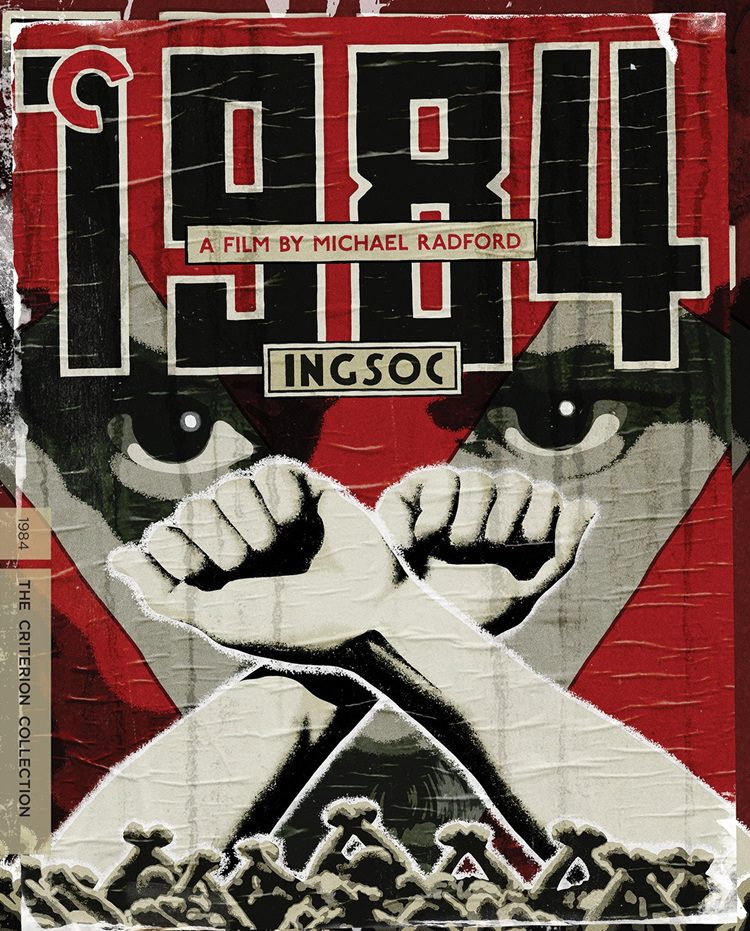
Based on George Orwell’s classic novel of the same name, writer-director Michael Radford’s Nineteen Eighty-Four tells the story of one man, Winston Smith, rebelling against the totalitarian system of Oceania, a country currently and, according to records, which has always been at war with Eurasia. That is until Smith reports “Oceania has always been at war with Eastasia…Eurasia has always been our ally.” The acceptance of conflicting ideas is doublethink, which the Party inflicts upon their citizens to control them. Winston rejects the fluidity of truth, as in 2+2 equaling whatever the Party says at any given time, rejects the evolving language, referred to as Newspeak, but can he do anything more than dream of “an age when thought is free from the age of Big Brother…from the age of the Thought Police”?
Buy Nineteen Eighty-Four (The Criterion Collection) Blu-rayAt a rally, the large crowd is whipped into a frenzy at the sight of its enemy, Emmanuel Goldstein, when he appears on screen. So much so, they are not listening to what he is saying about the Party to which they are all devoted, even though it will be revealed he is telling the truth. Instead, they have their own truths, which include the Party slogan: “War Is Peace, Freedom Is Slavery, Ignorance Is Strength.”
Oceania is a dreary place, looking war ravaged. People have hardly more than the essentials to survive. Items like razor blades are scarce. Winston (John Hurt) works for the Ministry of Information altering documents to align history with how the Party wants it to be remembered because “Who controls the past controls the future; who controls the present controls the past.” The Party strives for control, working to remove words from the common vocabulary and to eradicate the orgasm.
Winston visits a shop and buys a pretty trinket, pink coral in glass, some of the only bright color in his life. He notices a woman, Julia (Suzanna Hamilton). One day, she falls as they cross paths and sneaks him a note. Eventually, Winston rents a room from the shopkeeper to meet Julia and they begin a sexual affair, which is against the law. O’Brien (Richard Burton in his final performance) of the Inner Party approaches Winston. He gives him the Party’s new dictionary, which is actually a book by Goldstein, suggesting O’Brien’s allegiance may not be what it appears.
Soon after, Winston and Julia are discovered in the flat. Turns out they were set up by the shop owner to create propaganda for the Party. Winston is forced through torture to turn on Julia, to speak whatever “truth” the Party wants him to. He is freed, but only in the loosest definition of the word.
Michael Radford, his cast, and his crew do a brilliant job bringing Orwell’s novel to life. The work of the various crews, led by cinematographer Roger Deakins, production designer Allan Cameron, and others, evoke the oppressive Oceania. Hurt delivers an outstanding performance, conveying the range of emotions Winston experiences. Hamilton does a marvelous job slowly opening herself up to Winston in a world where that can mean her death. Burton evokes both an iciness and a warmth as O’Brien works with Winston.
Presented in its original aspect ratio of 1.85:1, encoded with MPEG-4 AVC and granted a 1080p transfer, the following text appears inside the leaflet that is provided with this Blu-ray release:
“Supervised by director of photography Roger Deakins, this new digital transfer was created in 16-bit 4K resolution on a Lasergraphics Director film scanner from the 35mm original camera negate at Deluxe in Hollywood. Thousands of instances of dirt, debris, scratches, splices, and warps were manually removed using MTI Film’s DRS, while Digital Vision’s Phoenix was used jitter, flicker, small dirt, grain, and noise management. The original monaural soundtrack was remastered from the 35mm magnetic track using Pro Tools HD and iZotope RX.”
Winston lives in a drab world of dark greens, browns, and blues. Even the off-white tile walls look dingy. There is a nice contrast in the lush greenery of the woods outside the city. Blacks are inky. The image looks clean with a natural film grain apparent as are texture details.
The audio is available in LPCM 1.0, with options for an orchestral score by Dominic Muldowney or an electronic score by the Eurythmics. Dialogue is clear throughout and balances well with the music and effects. The track sounds free of signs of wear or age.
The special features are
- Michael Radford (22 min) – Recorded for Criterion in 2019, this new interview with Radford explores his approach to working on the film, including the cinematography and score.
- Roger Deakins (20 min) – Also recorded for this release, this new interview with Deakins finds him talking about working with Radford, coming up with the look for the film, the new transfer.
- Behind the Scenes(1080i, 5 min) –A news segment shows Radford and actors Hurt and Hamilton shooting the scene where their characters meet, and interviews with them at various locations.
- David Ryan (22 min) – Also recorded for this release, David Ryan, author of George Orwell on Screen, discusses the themes of the novel, the making of the film, and the differences between it and past adaptations.
- Trailer
Nineteen Eighty-Four is a powerful story filled with concepts so universal that they remained accurate in 1984 when the film came out 25 years after the novel, still to do to this day over 40 years after the film’s release, and will likely remain so ad infinitum unless the essence of human beings change for the better. This film is a great adaptation of the novel. The Criterion Blu-ray delivers an impressive high-definition experience, with special features that allow one to dig deeper into the material and the source.